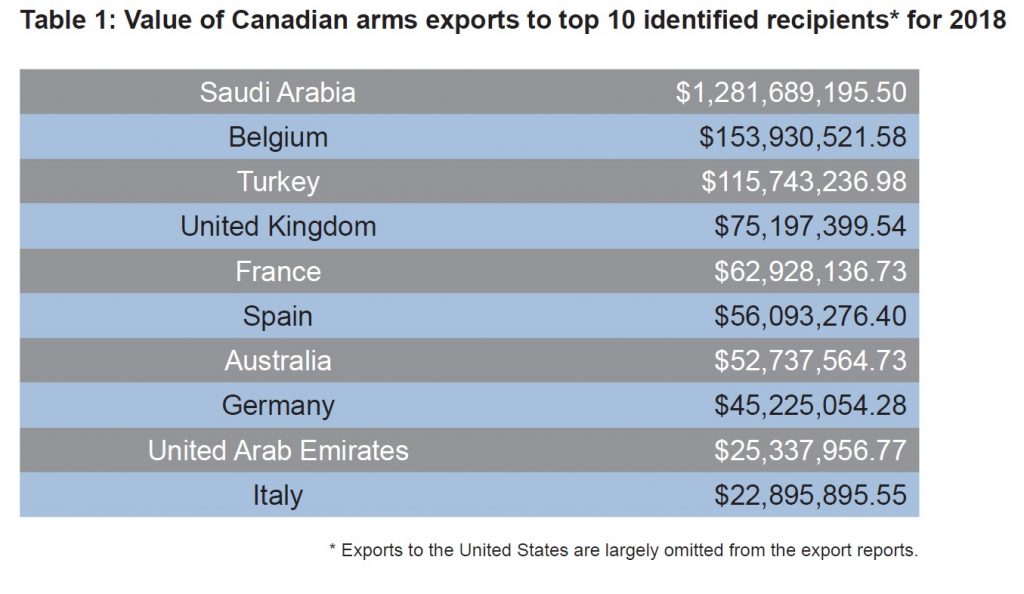Analyzing Canada’s 2018 Report on Exports of Military Goods
Published in The Ploughshares Monitor Volume 40 Issue 3 Autumn 2019
On June 20, Global Affairs Canada released its Report on Exports of Military Goods – 2018. Analysis of this report reveals several worrying trends: an increase in the number of exported weapons systems, a willingness to export such systems to serial human-rights abusers, and persistent gaps in reporting transparency.
A booming industry
Canadian weapons exports reached their highest level ever in 2018, far surpassing that of any year since Project Ploughshares began recording data in 1978. Total non-U.S. exports ballooned to $2.06-billion—more than the total for 2016 and 2017 combined.
Although 89 countries and territories received Canadian weapons in 2018, most went to the top 10 recipients (see Table 1). Seven of those 10—Belgium, Turkey, the United Kingdom, France, Spain, Germany, and Italy—are members of the North Atlantic Treaty Organization (NATO), to which Canada belongs. Both Belgium and Turkey moved up from the 2017 rankings, while the United Arab Emirates seized a top-10 spot for the first time.

The myth of strong export controls
While this latest export report describes 2018 as a “landmark year for Canadian arms control,” the evidence paints a different picture. Canadian companies exported vast amounts of weapons to states engaged in armed conflict and accused of human-rights violations, despite Canadian export regulations designed to prevent such transfers. Saudi Arabia, Turkey, Ukraine, and the United Arab Emirates were all involved in armed conflicts and accused of serious human-rights violations.
According to the report, in 2018, “Saudi Arabia was the largest non-U.S. export destination in 2018,” accounting for 62 per cent of all non-U.S. Canadian arms exports. After the United States, Saudi Arabia became the second country to exceed $1-billion in Canadian weapons exports in a single calendar year. Yet Saudi Arabia has an appalling human-rights record and is a lead party in the war in Yemen, described as the “world’s worst humanitarian crisis” by United Nations Secretary-General António Guterres. Evidence indicates that Saudi forces have used Canadian-made light-armoured vehicles in hostile actions, while other Canadian-made weapons have been diverted to Saudi-allied militias.
Expanding Canada’s Automatic Firearms Country Control List
Only states on Canada’s Automatic Firearms Country Control List (AFCCL) are approved to receive exports of Canadian automatic weapons. The list included 40 member states in 2018, unchanged from the previous year. States on the AFCCL now comprise nearly half of all countries buying Canadian weapons.
As noted in the 2018 export report, the process for inclusion on the AFCCL was streamlined with the 2018 adoption of Bill C-47—Canada’s domestic legislation to facilitate compliance with the terms of the Arms Trade Treaty. Previously, inclusion was preceded by a bilateral agreement. The new protocol only requires a “recommendation of the Minister of Foreign Affairs after consultation with the Minister of National Defence.”
This change could allow more states to get on the list. Discussions to add Japan and Mexico continue. However, the presence of Saudi Arabia on the list suggests that there are no meaningful restrictions.
Achieving greater transparency
In recent years, the Government of Canada has improved the transparency of its reporting of arms exports. But as the 2018 report reveals, limitations persist.
Weapons exports to the United States remain largely off-the-record. Since the 1956 Defence Production Sharing Agreement between Canada and the United States, Canada has omitted exports of military goods to the United States from conventional reporting procedures. But, as the 2018 report acknowledges, “an estimated half of all Canadian exports are to the U.S.”
Canadian reporting suffers from generalizations and sometimes fails to include key information. The latest report does not indicate the exact items that are exported. For example, instead of listing a precise model of rifle, with numbers exported, the report uses broad classifications, such as “automatic weapons with a calibre of 12.7 mm or less and accessories.” Yet we know that the government has the exact information, which is required before export permits are granted.
While the number of approved export permits is published, the number that are utilized is not. And, while figures of rejected permits have been included in the annual reports since 2016, the reasons for rejections are not published.
Canadian military aid to allied forces abroad is also not reported.
What happens now that Canada has joined the Arms Trade Treaty?
Canada exported a record amount of military goods in 2018. Such sales kept many Canadians employed and profited many Canadian companies.
At the same time, weapons were involved in killing, maiming, and threatening many people, including many noncombatants, around the world. Some of these weapons were made in Canada.
Global Affairs Canada has so far failed to explain how surging arms exports help to meet Canada’s core foreign-policy objectives, including the reduction of gender-based violence and achievement of the Sustainable Development Goals.
On September 17, Canada became a state party to the Arms Trade Treaty. As such, Canada assumed new responsibility to control the arms trade and promote transparency. We applaud Canada for joining this treaty, trusting that the government will fully meet all the attendant obligations.

